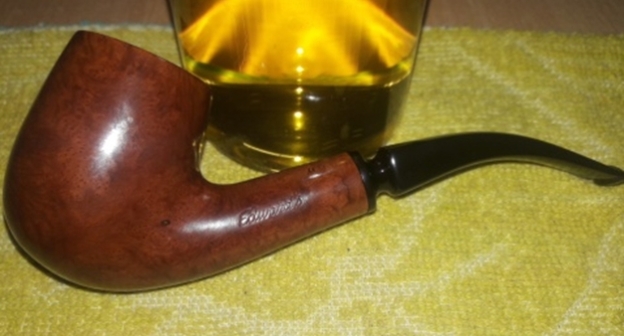Blog by Paresh Deshpande
One of the first restorations that I had undertaken was an Edward’s # 784 quarter bent Zulu. It was a very clean pipe to begin with and only required cleaning and shining of the stem and the stummel. There was not a single fill on that pipe and the feel of the stummel in the hand, briar, the grains and the stem oozed superior quality. I really liked that Zulu. The next pipe on my work table is an Edward’s # 712-L. This large sized bent billiard has a fantastic heft to it and fills the palm nicely, and I do have fairly large hands!! There are two minute fills on this huge stummel but, nevertheless, it is one handsome and robust looking pipe!!
The stummel surface boasts of beautiful swirls of grains interspersed with bird’s eye along the sides of the stummel, while cross grains adorn the top and bottom of the shank extending to the back of the stummel. The left hand of the shank is stamped as “Edward’s” in cursive hand. The right side of the shank is stamped as “ALGERIAN BRIAR” in block letters over “712- L” which probably is the shape and the letter denoting the large size. The bottom of the shank bears “# 7” near the shank end which in all probability is the model number. The fancy stem bears no stampings.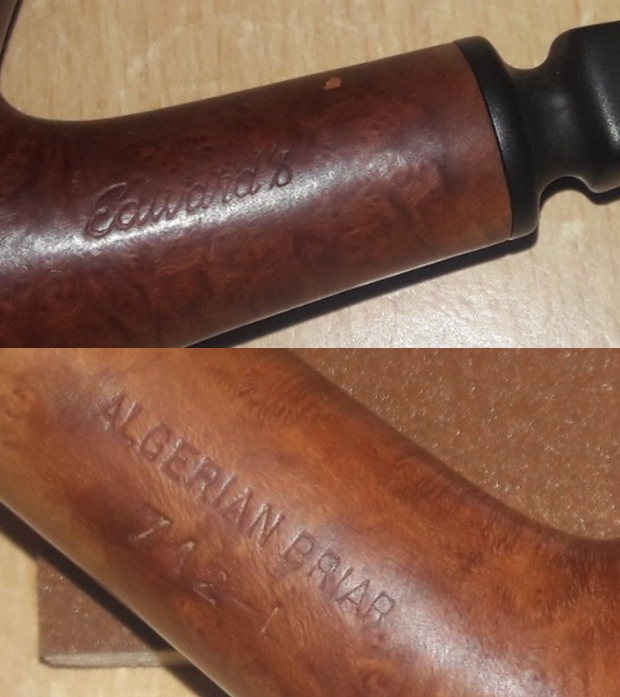 I searched pipedia.org for information and background of this brand and also attempt to date. I did not get the complete details that I was looking for, however the interesting information that I collected from this site was enough to convince me that the pipe I am currently working on is a no-push-over and can hold itself against some of the more known brands commanding a premium!! Here is the link to the information on pipedia.org (https://pipedia.org/wiki/Edward%27s). For those who prefer immediate results without wasting time, here is an important piece of information from the website:-
I searched pipedia.org for information and background of this brand and also attempt to date. I did not get the complete details that I was looking for, however the interesting information that I collected from this site was enough to convince me that the pipe I am currently working on is a no-push-over and can hold itself against some of the more known brands commanding a premium!! Here is the link to the information on pipedia.org (https://pipedia.org/wiki/Edward%27s). For those who prefer immediate results without wasting time, here is an important piece of information from the website:-
“All of Edward’s pipes are Algerian Briar – a fact very few pipe companies can claim, and all are oil-cured utilizing natural finishes – no strange concoctions are used to interfere in your tastebud’s dance with the briar. Algerian, Calabrian, Sardinian, Corsican – take your pick, but Algerian Briar is generally considered the finest smoking briar ever used. When combined with oil-curing, Algerian takes on a magical quality that even Alfred Dunhill recognized as far back as 1918 as the choice for both his Bruyere and Shell.”
I searched pipephil.eu in my attempt at dating this large handsome dude. Though I did not succeed in my endeavor, but I did get some interesting information like that Randy Wiley got his start at Edward’s!!!!!! Here is the link for those interested (http://www.pipephil.eu/logos/en/logo-e1.html). Even though this may not be a vintage pipe, but it definitely is of high quality and capable of holding itself up against some of the best in business!!!
INITIAL VISUAL INSPECTION
As I had noted earlier, this large bent billiard pipe was in great condition when I started restoring it. There were only two small fills on the shank, one on the left side near the bowl and shank joint and the other on the top surface of the shank, about an inch from the shank end. There is a small superficial chip in front of the bowl on the right side. The stummel is free of any spilled oils, tars or grime from the chamber. However, the briar is dull and lifeless and has taken on a layer of aged patina, through which one can make out the beautiful grains all round. This one should clean up nicely.
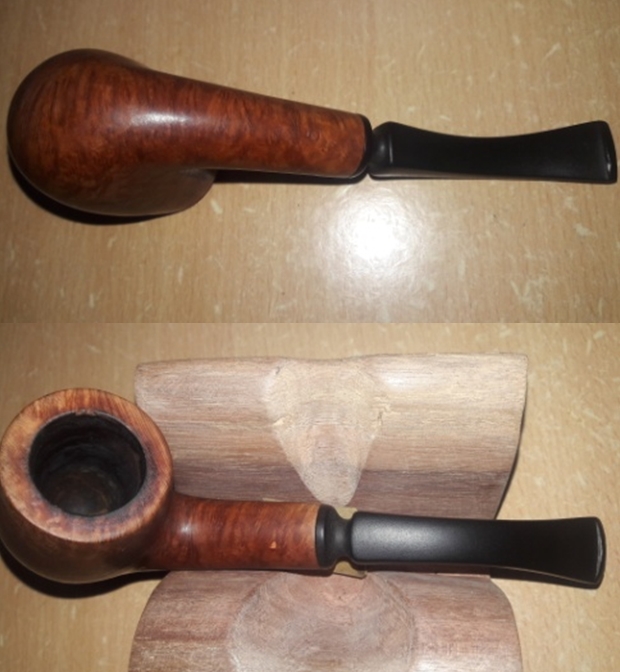
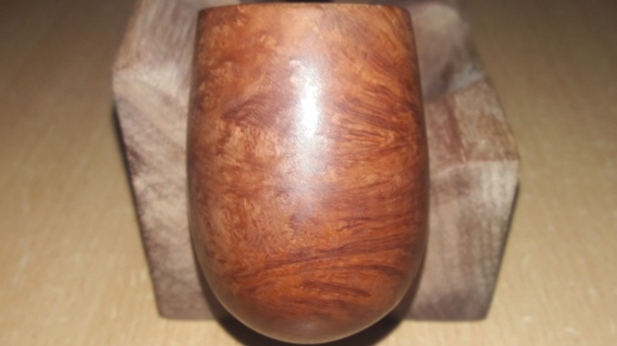 The pipe appears to have been smoked a few times and there is a very thin layer of cake in the chamber. The chamber walls are nice and thick with no apparent damage. There is a minuscule amount of lava overflow on the rim surface. There are two small dents on the inner rim edge in 3 o’clock direction. The outer rim edge is slightly damaged in 12 o’clock direction, the result of likely being banged against a hard surface. The mortise is as clean as can be and the airflow through it is free and smooth. These issues should be a breeze to address.
The pipe appears to have been smoked a few times and there is a very thin layer of cake in the chamber. The chamber walls are nice and thick with no apparent damage. There is a minuscule amount of lava overflow on the rim surface. There are two small dents on the inner rim edge in 3 o’clock direction. The outer rim edge is slightly damaged in 12 o’clock direction, the result of likely being banged against a hard surface. The mortise is as clean as can be and the airflow through it is free and smooth. These issues should be a breeze to address.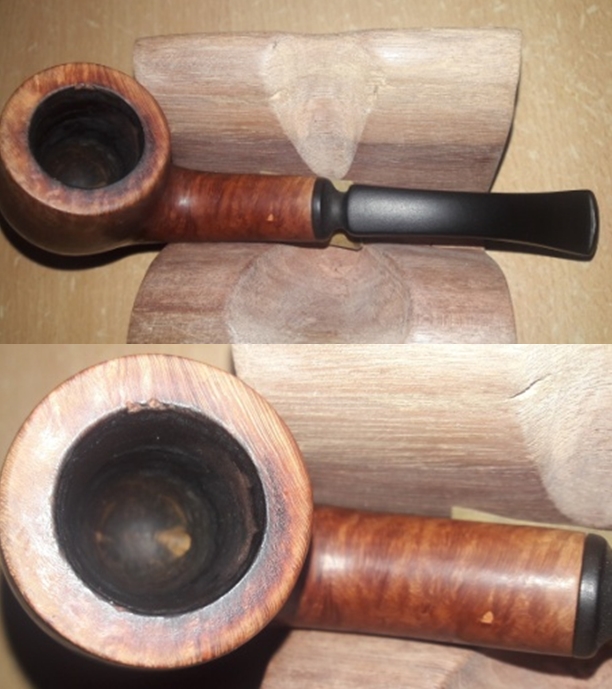
 The vulcanite stem is without any bite marks or tooth chatter. There are small bite marks on the lower and upper lip edges. It is nice and dark, but not smooth. The roughness is due to oxidation of the top surface. These issues should not be a major headache to address. The tenon is clean and flow of air through the airway is full and smooth.
The vulcanite stem is without any bite marks or tooth chatter. There are small bite marks on the lower and upper lip edges. It is nice and dark, but not smooth. The roughness is due to oxidation of the top surface. These issues should not be a major headache to address. The tenon is clean and flow of air through the airway is full and smooth.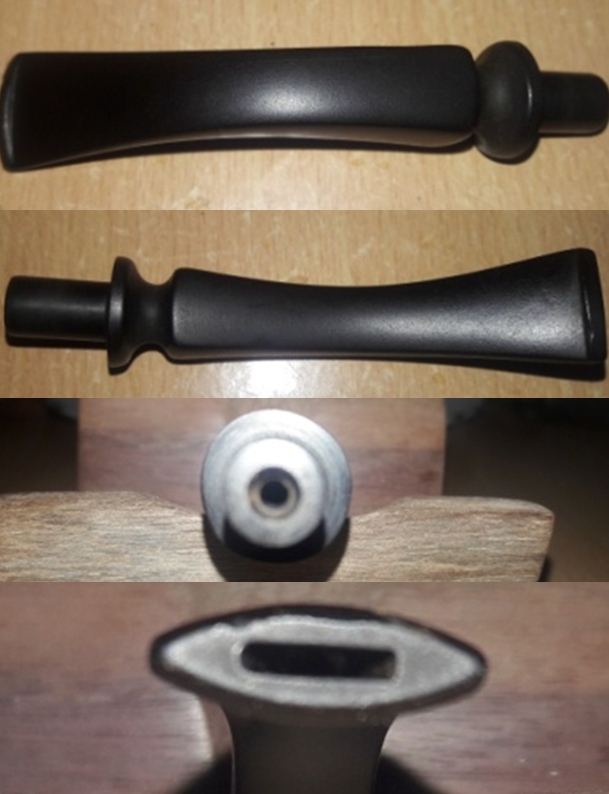 THE PROCESS
THE PROCESS
I started this project by cleaning the chamber. Since there was a very thin layer of carbon, I used a 220 grit sand paper, pinched between my thumb and forefinger, to sand the inner walls of the chamber. Once I had reached the bare briar, I wiped the chamber with a cotton pad dipped in isopropyl alcohol. This removed all the residual carbon dust and also rid the chamber of all ghost smells. I worked on the inner edge of the rim and on the rim surface with a 220 grit sand paper. I realized that the nicks to the inner edge were larger than anticipated and also the rim surface had some blackened surfaces. I addressed these issues by topping the rim on a 220 grit sand paper. This addressed all the issues on the rim, including the damage to the outer edge of the rim. Now, it was the turn of the stummel to get cleaned up. Using a hard bristled tooth brush dipped in undiluted Murphy’s oil soap, I very deliberately scrubbed the stummel, cleaning the surface thoroughly. I cleaned the rim too. The stummel and rim top was dried using paper napkins and soft cotton cloth.
Now, it was the turn of the stummel to get cleaned up. Using a hard bristled tooth brush dipped in undiluted Murphy’s oil soap, I very deliberately scrubbed the stummel, cleaning the surface thoroughly. I cleaned the rim too. The stummel and rim top was dried using paper napkins and soft cotton cloth.

 I gouged out the old fills on the shank and the chipped portion on the front of the bowl with a pointed knife and wiped the area clean with a cotton swab dipped in isopropyl alcohol. I spot filled these with clear CA superglue and set it aside to cure.
I gouged out the old fills on the shank and the chipped portion on the front of the bowl with a pointed knife and wiped the area clean with a cotton swab dipped in isopropyl alcohol. I spot filled these with clear CA superglue and set it aside to cure.
 While the stummel was drying, I worked the stem. I sharpened the lip edges using a needle file. I sand the entire stem with 220 followed by 400 and 800 grit sand paper. This helps to reduce the sanding marks left behind by the more abrasive 220 grit paper. To bring a deep shine to the vulcanite stem, I went through the complete set of micromesh pads, wet sanding with 1500 to 2400 grit pads and dry sanding with 3200 to 12000 grit pads. I wiped the stem with alcohol after each pad and rubbed it down with Extra Virgin Olive oil. The internals of the stem was cleaned out using alcohol and pipe cleaners. The pictures of the process and final results are shown below.
While the stummel was drying, I worked the stem. I sharpened the lip edges using a needle file. I sand the entire stem with 220 followed by 400 and 800 grit sand paper. This helps to reduce the sanding marks left behind by the more abrasive 220 grit paper. To bring a deep shine to the vulcanite stem, I went through the complete set of micromesh pads, wet sanding with 1500 to 2400 grit pads and dry sanding with 3200 to 12000 grit pads. I wiped the stem with alcohol after each pad and rubbed it down with Extra Virgin Olive oil. The internals of the stem was cleaned out using alcohol and pipe cleaners. The pictures of the process and final results are shown below.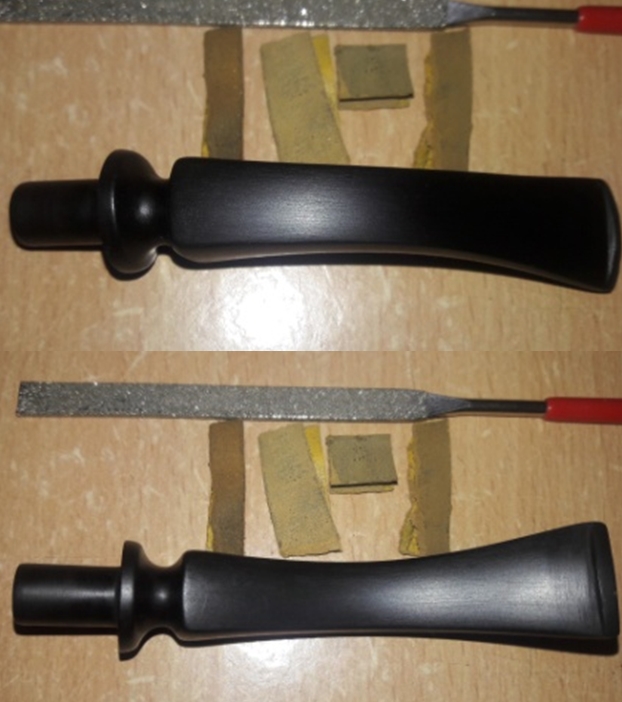
 The fills on the stummel had cured. Using a 220 grit sand paper, pinched between my thumb and forefinger, I sand the fills and the entire stummel to match each other.
The fills on the stummel had cured. Using a 220 grit sand paper, pinched between my thumb and forefinger, I sand the fills and the entire stummel to match each other.

 I wanted to highlight the grains seen and further blend all the repairs carried out to the stummel. To achieve this aim, I sand down the stummel and rim top using micromesh pads, wet sanding with 1500 to 2400 grit pads and dry sanding with 3200 to 12000 grit pads. The stummel now has a deep shine with grains popping out with magnificent contrast.
I wanted to highlight the grains seen and further blend all the repairs carried out to the stummel. To achieve this aim, I sand down the stummel and rim top using micromesh pads, wet sanding with 1500 to 2400 grit pads and dry sanding with 3200 to 12000 grit pads. The stummel now has a deep shine with grains popping out with magnificent contrast.

 I rub a small quantity of “Before and After Restoration Balm” in to briar and let it rest for a few minutes. The balm almost immediately works its magic and the briar now has a nice vibrant appearance. I further buff it with a horse hair shoe brush.
I rub a small quantity of “Before and After Restoration Balm” in to briar and let it rest for a few minutes. The balm almost immediately works its magic and the briar now has a nice vibrant appearance. I further buff it with a horse hair shoe brush.
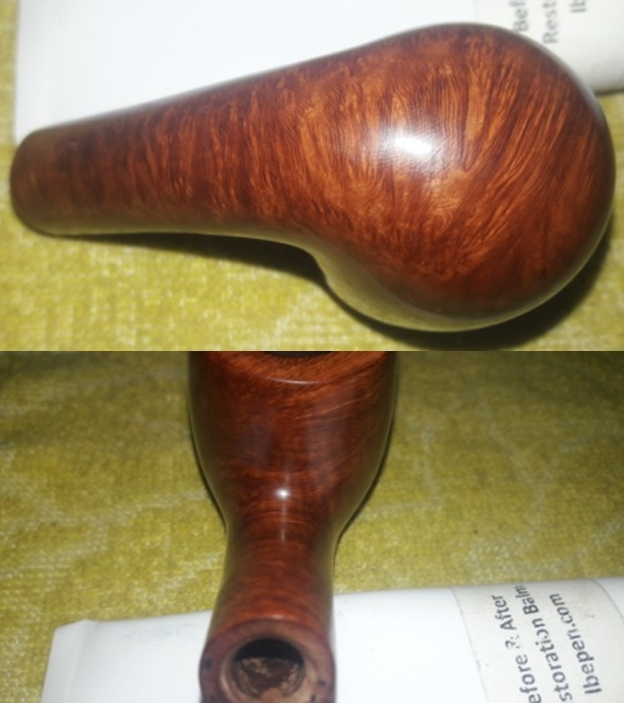
 To finish, I re-attach the stem with the stummel. I mount a cotton cloth buffing wheel on to the Dremel (actually it is not the brand machine, but a local machine which is similar). I set the speed at about half of the full power and applied White Diamond compound to the entire pipe. I wiped/ buffed the pipe with a soft cotton cloth to clear it of any leftover compound dust. I then mounted another cotton cloth wheel on to the polishing machine and applied several coats of carnauba wax. I finished the restoration by giving the entire pipe a rigorous hand buffing using a microfiber cloth to raise the shine further.
To finish, I re-attach the stem with the stummel. I mount a cotton cloth buffing wheel on to the Dremel (actually it is not the brand machine, but a local machine which is similar). I set the speed at about half of the full power and applied White Diamond compound to the entire pipe. I wiped/ buffed the pipe with a soft cotton cloth to clear it of any leftover compound dust. I then mounted another cotton cloth wheel on to the polishing machine and applied several coats of carnauba wax. I finished the restoration by giving the entire pipe a rigorous hand buffing using a microfiber cloth to raise the shine further.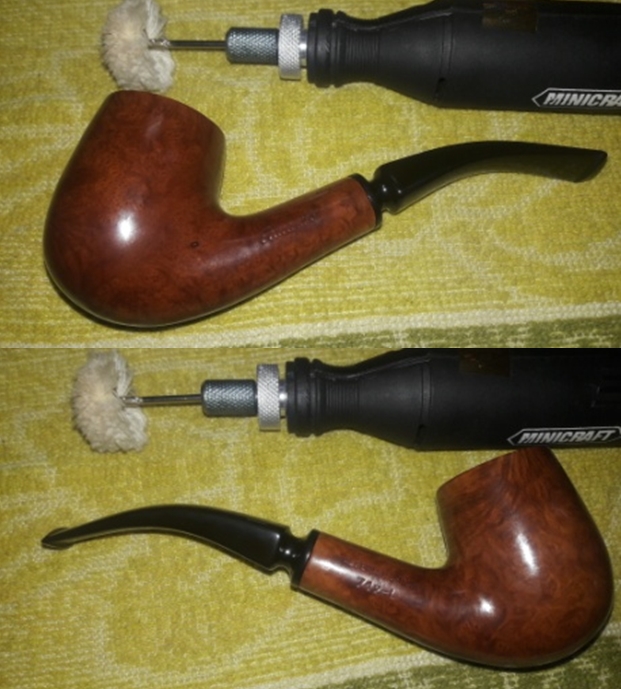
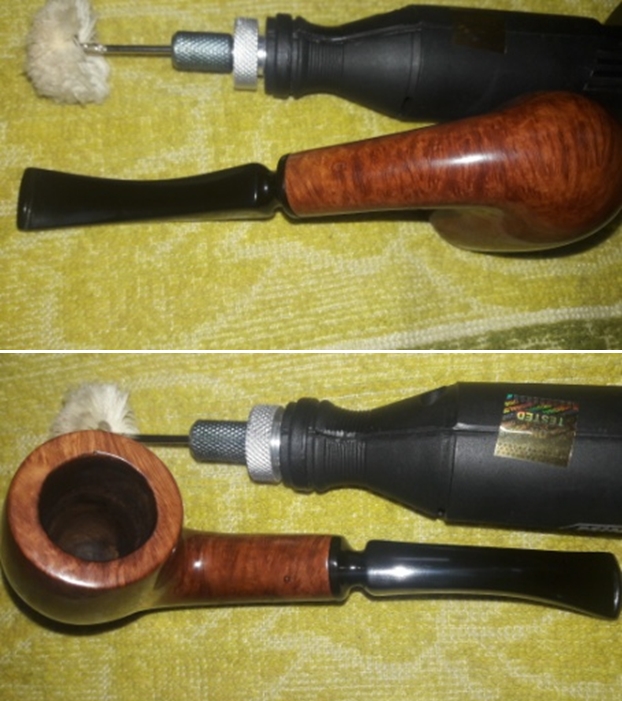 The completed pipe, with the dark brown hues of the stummel contrasting with the shiny black stem, looks lovely, fresh and vibrant; the photographs speak for themselves. The beauty, size and shape of this pipe compel me to wonder how anyone could let go of such a robust and beautiful looking pipe! If only the pipe could tell the story of its journey till date…………… Cheers!
The completed pipe, with the dark brown hues of the stummel contrasting with the shiny black stem, looks lovely, fresh and vibrant; the photographs speak for themselves. The beauty, size and shape of this pipe compel me to wonder how anyone could let go of such a robust and beautiful looking pipe! If only the pipe could tell the story of its journey till date…………… Cheers!






